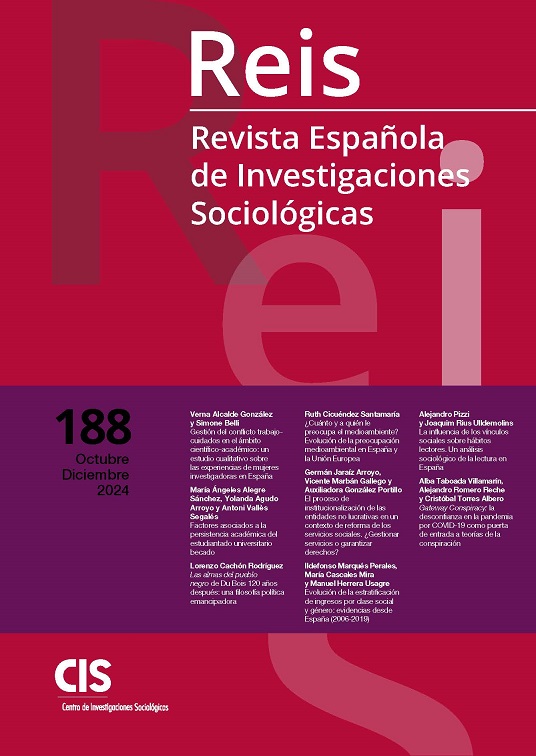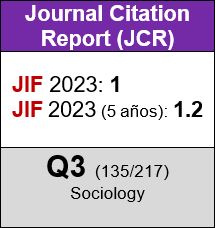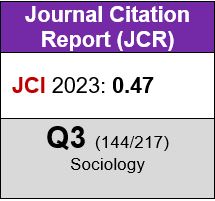Evolución de la estratificación de ingresos por clase social y género: evidencias desde España (2006-2019)
DOI:
https://doi.org/10.5477/cis/reis.188.101-120Palabras clave:
Clase social, Desigualdades sociales, Estratificación social, Género, Índice de estratificación de ingresosResumen
La presente investigación aborda la estratificación de ingresos por clase social y género en la población trabajadora española, desde
el año 2006 al 2019. A través del Índice S de Zhou (2012) se mide el nivel de estratificación por grupos, informando acerca de si la
clase social y el género afectan a la distribución de ingresos. Los datos provienen de la Encuesta de Condiciones de Vida del Instituto
Nacional de Estadística. Como principales resultados destacamos: la vinculación entre clase social e ingresos persiste; se aprecia una reducción en la estratificación de ingresos por género tras la crisis; y se observa una mayor polarización de ingresos en el grupo de mujeres. La principal aportación al campo es emplear un índice de estratificación de ingresos frente a los clásicos estudios de desigualdad.
Descargas
Citas
Allanson, Paul (2018). «On the Measurement of the Overall Degree of Income Stratification between Groups». Review of Income and Wealth, 64(2): 388-405. doi: 10.1111/roiw.12290 DOI: https://doi.org/10.1111/roiw.12290
Allison, Paul D. (1978). «Measures of Inequality». American Sociological Review, 43(6): 865-880. doi: 10.2307/2094626 DOI: https://doi.org/10.2307/2094626
Bauman, Zygmunt (2007). Consuming Life. First Edition. Cambridge: Polity Press.
Beck, Ulrich y Willms, Johannes (2004). Conversations with Ulrich Beck. Polity.
Breen, Richard (2004). Social Mobility in Europe. Oxford; New York: Oxford University Press. DOI: https://doi.org/10.1093/0199258457.001.0001
Buchmann, Claudia; DiPrete, Thomas A. y McDaniel, Anne (2008). «Gender Inequalities in Education». Annual Review of Sociology, 34(1): 319-337. doi: 10.1146/annurev.soc.34.040507.134719 DOI: https://doi.org/10.1146/annurev.soc.34.040507.134719
Carrasquer, Pilar y Amaral-Pinto, Mariana do (2019). El terra enganxós de les dones a la ciutat de Barcelona. Barcelona: Ajuntament de Barcelona, Barcelona Activa.
Cebrián-López, Inmaculada C. y Moreno, Gloria (2018). «Desigualdades de género en el mercado laboral». Panorama social (27): 47-63.
Clark, Terry N. y Lipset, Seymour M. (1991). «Are Social Class Dying?» International Sociology, 6(4): 397-410. doi: 10.1177/026858091006004002 DOI: https://doi.org/10.1177/026858091006004002
Domínguez-Folgueras, Marta (2024). «Parentalidad y división del trabajo doméstico en España, 2002-2010». Revista Española de Investigaciones Sociológicas, (149): 45-64. doi: 10.5477/cis/reis.149.45 DOI: https://doi.org/10.5477/cis/reis.149.45
Domínguez-Folgueras, Marta; González, M. José y Lapuerta, Irene (2022). «The Motherhood Penalty in Spain: The Effect of Full- and Part-Time Parental Leave on Women’s Earnings». Social Politics: International Studies in Gender, State & Society, 29(1): 164-189. doi: 10.1093/sp/jxab046 DOI: https://doi.org/10.1093/sp/jxab046
Dueñas-Fernández, Diego; Iglesias-Fernández, Carlos y Llorente-Heras, Raquel (2014). «Occupational Segregation by Sex in Spain: Exclusion or Confinement?» International Labour Review, 153(23): 11-36. doi: 10.1111/j.1564-913X.2014.00206.x DOI: https://doi.org/10.1111/j.1564-913X.2014.00206.x
England, Paula (2010). «The Gender Revolution: Uneven and Stalled». Gender and Society, 24(21): 49-66. DOI: https://doi.org/10.1177/0891243210361475
England, Paula; Bearak, Jonathan; Budig, Michelle J. y Hodges, Melissa J. (2016). «Do Highly Paid, Highly Skilled Women Experience the Largest Motherhood Penalty?» American Sociological Review, 81(61): 161-189. doi: 10.1177/0003122416673598 DOI: https://doi.org/10.1177/0003122416673598
Erikson, Robert y Goldthorpe, John H. (1992). The Constant Flux: A Study of Class Mobility in Industrial Societies. Oxford [UK]; New York: Clarendon Press; Oxford University Press.
Erikson, Robert; Goldthorpe, John H. y Portocarero, Lucienne (1979). «Intergenerational Class Mobility in Three Western European Societies: England, France and Sweden». The British Journal of Sociology, 30(4): 415. doi: 10.2307/589632 DOI: https://doi.org/10.2307/589632
Esping-Andersen, Gosta (1999). Social Foundations of Postindustrial Economies. 1.a ed. Oxford: Oxford University Press. DOI: https://doi.org/10.1093/0198742002.003.0001
Fachelli, Sandra y López-Roldán, Pedro (2015). «¿Somos más móviles incluyendo a la mitad invisible? Análisis de la movilidad social intergeneracional en España en 2011». Revista Española de Investigaciones Sociológicas, (150): 41-70. doi: 10.5477/cis/reis.150.41 DOI: https://doi.org/10.5477/cis/reis.150.41
Fuller, Sylvia (2018). «Segregation across Workplaces and the Motherhood Wage Gap: Why Do Mothers Work in Low-Wage Establishments?» Social Forces, 96(4): 1443-1476. doi: 10.1093/sf/sox087 DOI: https://doi.org/10.1093/sf/sox087
Gálvez-Muñoz, Lina y Rodríguez-Modroño, Paula (2011). «La desigualdad de género en las crisis económicas». Investigaciones Feministas (2): 113-32. DOI: https://doi.org/10.5209/rev_INFE.2011.v2.38607
Goldthorpe, John H. (2000). On Sociology: Numbers, Narratives, and the Integration of Research and Theory. Oxford [UK]; New York: Oxford University Press. DOI: https://doi.org/10.1093/oso/9780198295716.001.0001
Goldthorpe, John H. (2012). «Back to Class and Status: Or Why a Sociological View of Social Inequality Should Be Reasserted». Revista Española de Investigaciones Sociológicas, (137): 43-58. DOI: https://doi.org/10.5477/cis/reis.137.201
Goldthorpe, John H. y McKnight, Abigail (2004). The Economic Basis of Social Class. 80. Centre for Analysis of Social Exclusion. LSE.
González-Rodríguez, Juan J. y Garrido-Medina, Luis J. (2005). Mercado de trabajo, ocupación y clases sociales. En: Tres décadas de cambio social en España, (pp. 89-134). Madrid: Alianza.
Hertel, Florian R. (2017). Social Mobility in the 20th Century. Wiesbaden: Springer Fachmedien. DOI: https://doi.org/10.1007/978-3-658-14785-3
Hurley, John; Storrie, Donald y Jungblut, Jean-Marie (2011). Shifts in the Job Structure in Europe during the Great Recession. Luxembourg: Publications Office of the European Union.
Ibáñez-Pascual, Marta (2017). Mujeres en mundos de hombres: la segregación ocupacional a través del estudio de casos. Madrid: Centro de Investigaciones Sociológicas.
Iversen, Torben (2010). Women, Work, and Politics the Political Economy of Gender Inequality. New Haven: Yale University Press.
Karpiński, Zbigniew y Skvoretz, John (2023). «Status Allocation from Elementary Allocation Principles». Research in Social Stratification and Mobility, (83): 100769. doi: 10.1016/j.rssm.2023.100769 DOI: https://doi.org/10.1016/j.rssm.2023.100769
Kingston, Paul W. (2000). The Classless Society. Stanford University Press.
Lasswell, Thomas E. (1965). Class and Stratum, An Introduction to Concepts and Research. First Edition. Houghton Mifflin Company.
Le Grand, Carl y Tåhlin, Michael (2013). Class, Occupation, Wages, and Skills: The Iron Law of Labor Market Inequality. En: G. Elisabeth Birkelund (ed.). Class and Stratification Analysis. (Vol. 30, Comparative Social Research, pp. 3-46). Emerald Group Publishing Limited. DOI: https://doi.org/10.1108/S0195-6310(2013)0000030006
Manduca, Robert A. (2019). «The Contribution of National Income Inequality to Regional Economic Divergence». Social Forces, 98(2): 622-48. doi: 10.1093/sf/soz013 DOI: https://doi.org/10.1093/sf/soz013
Marqués-Perales, Ildefonso y Herrera-Usagre, Manuel (2010). «¿Somos más móviles? Nuevas evidencias sobre la movilidad intergeneracional de clase en España en la segunda mitad del siglo XX». Revista Española de Investigaciones Sociológicas, (131): 43-73. DOI: https://doi.org/10.5477/cis/reis.131.43
Marqués-Perales, Ildefonso y Gómez-Espino, Juan Miguel (2023). «The Role of Working Women in Social Mobility in Spain». International Sociology, 38(3): 311-333. doi: 10.1177/02685809221150753 DOI: https://doi.org/10.1177/02685809221150753
Molina, José Alberto y Montuenga, Víctor M. (2008). The Motherhood Wage Penalty in a Mediterranean Country: The Case of Spain. 3574. Bonn: IZA Institute of Labour Economics.
Nolan, Brian; Weisstanner, David; Goedemé, Tim y Paskov, Marii (2020). «Social Class and Earnings: A Cross-National Study». INET Oxford Working Papers.
Oesch, Daniel (2006). Redrawing the Class Map. London: Palgrave Macmillan UK. DOI: https://doi.org/10.1057/9780230504592
Ortíz-García, Pilar (2014). «El trabajo a tiempo parcial. ¿Una alternativa para la mujer en tiempos de crisis?» Sociología del Trabajo, 3(82): 73-92.
Pakulski, Jan y Waters, Malcolm (1996). The death of class. Thousand Oaks, Calif: SAGE.
Parent-Thirion, Agnès; Biletta, Isabella; Cabrita, Jorge; Llave Vargas, Oscar; Vermeylen, Greet; Wilczynska, Aleksandra y Wilkens, Mathijn (2017). 6th European Working Conditions Survey: Overview Report. 2017 update. Luxembourg: Publications Office of the Euroepan Union. DOI: https://doi.org/10.1136/oemed-2018-ICOHabstracts.36
Sánchez-Mira, Núria y O’Reilly, Jacqueline (2019). «Household Employment and the Crisis in Europe». Work, Employment and Society, 33(3): 422-43. doi: 10.1177/0950017018809324 DOI: https://doi.org/10.1177/0950017018809324
Santos-Ortega, Juan Antonio (2012). «La bolsa y la vida»: Efectos de la lógica financiera sobre los mercados de trabajo precarios. En: L. E. Alonso-Benito y C. J. Fernández-Rodríguez (ed.). La financiarización de las relaciones salariales: una perspectiva internacional, (pp. 127-57). Madrid: FUHEM Ecosocial: Los libros de la catarata.
Sevilla-Sanz, Almudena; Gimenez-Nadal, Jose Ignacio y Fernández, Cristina (2010). «Gender Roles and the Division of Unpaid Work in Spanish Households». Feminist Economics, 16(4): 137-84. doi: 10.1080/13545701.2010.531197 DOI: https://doi.org/10.1080/13545701.2010.531197
Shoki, Okubo; Keisuke, Kawata; Ting, Yin y Zhaoyuan, Xu (2019). Wage Stratification between Care Workers and Non-Care Workers in Japan: Evidence from 2001-2017. Discussion Paper. FY2019. Research Institute of Economy, Trade and Industry.
Tåhlin, Michael (2007). «Class Clues». European Sociological Review, 23(5): 557-72. doi: 10.1093/esr/jcm019 DOI: https://doi.org/10.1093/esr/jcm019
Trapido, Denis (2006). «Gendered Transition: Post-Soviet Trends in Gender Wage Inequality among Young Full-Time Workers». European Sociological Review, 23(2): 223-37. doi: 10.1093/esr/jcl030 DOI: https://doi.org/10.1093/esr/jcl030
Treiman, Donald J. (1976). «A Standard Occupational Prestige Scale for Use with Historical Data». The Journal of Interdisciplinary History, 7(2): 283-304. doi: 10.2307/202737 DOI: https://doi.org/10.2307/202737
Tumin, Melvin M. (1984). Social Stratification: The Forms and Functions of Inequality. 2nd edition. Englewood Cliffs, N.J: Prentice-Hall.
Warner, Geoffrey (2000). «A Lorenz Curve Based Index of Income Stratification». The Review of Black Political Economy, 28(3): 41-57. doi: 10.1007/BF02717269 DOI: https://doi.org/10.1007/BF02717269
Williamson, Oliver E. (1985). The Economic Institutions of Capitalism: Firms, Markets, Relational Contracting. Free Press.
Wright, Erik O. (1979). Class Structure and Income Determination. Academic Press.
Wright, Erik O. (2018). Comprender las clases sociales. Barcelona: Akal.
Yitzhaki, Shlomo y Lerman, Robert I. (1991). «Income Stratification and Income Inequality». Review of Income and Wealth, 37(3): 313-329. doi: 10.1111/j.1475-4991.1991.tb00374.x DOI: https://doi.org/10.1111/j.1475-4991.1991.tb00374.x
Zhou, Xiang (2012). «A Nonparametric Index of Stratification». Sociological Methodology 42(1): 365-389. doi: 10.1177/0081175012452207 DOI: https://doi.org/10.1177/0081175012452207
Zhou, Xiang y Wodtke, Geoffrey T. (2019). «Income Stratification among Occupational Classes in the United States». Social Forces, 97(3): 945-972. doi: 10.1093/sf/soy074 DOI: https://doi.org/10.1093/sf/soy074
Descargas
Publicado
Cómo citar
Número
Sección
Licencia
Derechos de autor 2024 Revista Española de Investigaciones Sociológicas

Esta obra está bajo una licencia internacional Creative Commons Atribución-CompartirIgual 4.0.
Permite Compartir — copiar y redistribuir el material en cualquier medio o formato, Adaptar — remezclar, transformar y construir a partir del material para cualquier propósito, incluso comercialmente.








